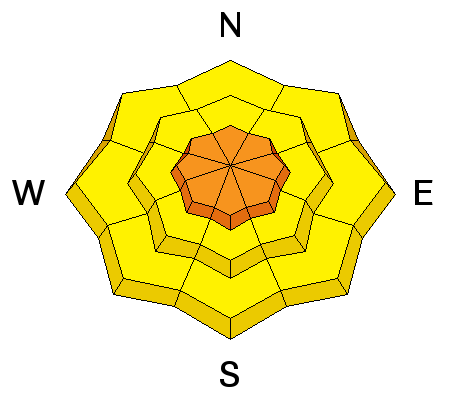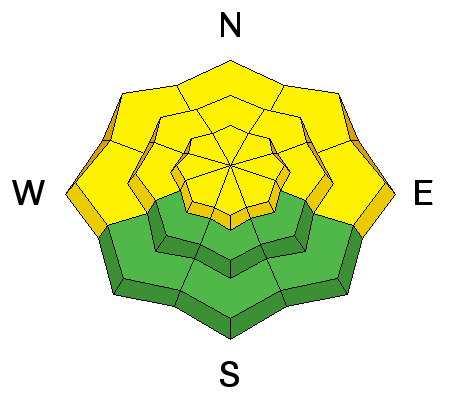25th Annual Black Diamond Fall Fundraising Party
Thursday, September 13; 6:00-10:00 PM; Black Diamond Parking Lot

25th Annual Black Diamond Fall Fundraising Party
Thursday, September 13; 6:00-10:00 PM; Black Diamond Parking Lot
| Advisory: Ogden Area Mountains | Issued by Drew Hardesty for Sunday - January 22, 2017 - 7:19am |
|---|
 |
special announcement If you sign up for AmazonSmile and designate the Utah Avalanche Center as your favorite charity, they will donate a portion of everything you spend to the UAC. I doesn't cost you a penny and we'd really appreciate the help. I'll be hosting the Fireside Chat at the Black Diamond store this Thursday at 7pm. Topic: Expert Intuition in High Risk - Low Frequency Events. Best if you have a decent grasp of the different avalanche problems, but all are welcome to this informal, low key, picnic - style gathering. |
 |
current conditions And the storms march on, a million snowflakes at a time. The weather gods indeed look fondly upon the Wasatch Range, though let's not forget how mischievous or mercurial they can be. (Skip down to Mountain Weather). Many areas picked up another trace to a couple inches overnight before the skies trended partly cloudy into the wee hours. Mountain temps are now in the mid to upper teens. Winds have now backed to the west southwest ahead of the next system, blowing 15-20mph with gusts to 25 on Mt Ogden and James Peak. Storm totals are 10-14". Week in Review by Greg Gagne Not much to report. A dominant ridge of high pressure with clear skies and cold nights through late this past week and into Wednesday led to a weakening of the snow surface on many aspects, with several observations noting surface hoar crystals as well as near-surface facets. Winds began to increase on Wednesday night and into Thursday morning, before diminishing midday on Thursday. A weak storm system deposited 3-5" in the Salt Lake mountains on Thursday. On Wednesday, pro observer Mark White provided - as usual - an excellent observation of the snow surface prior to Thursday's small storm. Note how he highlights a thin temperature crust on west aspects that cap weaker faceted snow underneath. Observations from Thursday in the Salt Lake mountains indicated winds and warm temperatures likely destroyed the surface hoar layer ahead of the snowfall, but the layer of near-surface facets has been preserved on many shady aspects at the mid and upper elevations underneath Thursday's storm snow. |
 |
recent activity Pro observer and part-time Snowbasin patroller Doug Wewer noted collapsing in the low elevations on the Cutler Ridge and then intentionally triggered a 10" deep and 100' wide storm slab on a steep east facing convexity at 8600'. The avalanche ran on faceted snow buried on Thursday. In the Snowbasin periphery, Bill Hunt found very sensitive conditions from 9300' down to 7900'. Sluffing noted at even lower elevations. Most of these were described as quite sensitive and up to a foot or so deep. (pics: Hunt, Wewer)
|
| type | aspect/elevation | characteristics |
|---|


|


|

LIKELIHOOD
 LIKELY
UNLIKELY
SIZE
 LARGE
SMALL
TREND
 INCREASING DANGER
SAME
DECREASING DANGER
|
|
description
Developing wind slabs up to 2' thick will be sensitive to human provocation and more readily found on the steep north to east to south facing slopes. Yesterday's moderate to strong westerlies...along with today's ramping west to southwest winds will make wind drifts your primary concern. Look for smooth and rounded pillows to the lee of ridgelines and cross-loaded beyond spines and sub-ridges. Listen for the tell-tale signs of collapsing; watch for shooting cracks: both active signs from the snowpack that say Do Not Touch .
With thanks to Mark White and genius of our time Gary Larson |
| type | aspect/elevation | characteristics |
|---|


|


|

LIKELIHOOD
 LIKELY
UNLIKELY
SIZE
 LARGE
SMALL
TREND
 INCREASING DANGER
SAME
DECREASING DANGER
|
|
description
The glue has yet to dry; that is, that many interfaces and weaknesses within the storm snow failed and avalanched yesterday and the snow will need a bit more time to adjust and gain strength. Naturals are not expected within the storm snow, but human triggered slides within these "intra-storm' weaknesses will still be possible in steep terrain of all aspects and elevations. Test slopes, cornice drops, and simple snow tests should provide good information on localized instability. |
| type | aspect/elevation | characteristics |
|---|


|


|

LIKELIHOOD
 LIKELY
UNLIKELY
SIZE
 LARGE
SMALL
TREND
 INCREASING DANGER
SAME
DECREASING DANGER
|
|
description
Weak surface snow (facets and patches of surface hoar), buried by myriad sun, wind, and temperature crusts lay dormant. I don't anticipate these weaknesses to be a primary player today, but if activated with enough weight (perhaps more likely with this afternoon's additional strong winds), they'll result in larger, more unmanageable avalanches. Collapsing is a sign of instability. |
 |
weather Another storm on the doorstep, but this one will be initially wet, warm and windy...with 1-2' of storm snow possible through Tuesday...with flurries through early Thursday. The southwest winds will begin in earnest by late morning and should reach sustained hourly averages of 40mph by the afternoon...and then perhaps 50mph overnight. Precipitation will start and sputter by the afternoon with only a couple inches of snow expected by dinnertime. Snowfall intensities will pick up overnight and into tomorrow with a cold front mid-morning. Today we'll have overcast skies with temps warming to near 20F at 9500'. |
general announcements
|